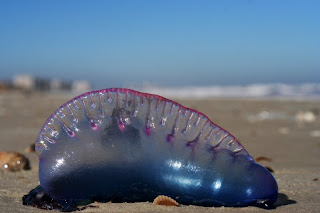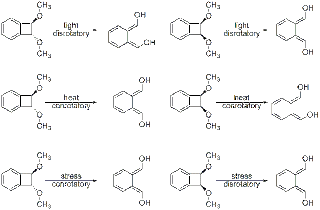 Image from Carlos J. Hernandez/Thomas G. Mason, UCLA Chemistry. This image is published in the Journal of Physical Chemistry C.
Image from Carlos J. Hernandez/Thomas G. Mason, UCLA Chemistry. This image is published in the Journal of Physical Chemistry C."Colloidal Alphabet Soup: Monodisperse Dispersions of Shape-Designed LithoParticles" by the Mason group at UCLA is the cover article for the Journal of Physical Chemistry C this week. Although this article was brought to my attention by my husband (a physical chemist of course), I found it interesting nonetheless. Taking advantage of high-throughput automated stepper lithography, graduate student Hernandez literally generated a soup of three-dimensional colloidal particles--including letters of the alphabet, crosses capable of alignment and formation of columnar structures, donut particles that can aggregate to form tubes as well as various combinations of the above. Lithioparticles, as the authors call these miniature polymeric colloids, range in size from micron to submicron units and can be colored through the incorporation of green, red, or blue fluorescent dyes.
So what exactly is "stepper lithography"? First, both a sacrificial layer and a polymeric photoresist layer are placed on top of a silicon wafer through a process known as spin coating. Using the "stepper," or a fully automated lithiographic projection exposure system, UV light is shined through a stencil-like "mask"and through the stepper's lens onto the photoresist layer. This step crosslinks the part of the photoresist that was exposed to UV light (the part not covered by the "mask"). Exposure to an organic developing solvent removes the unexposed photoresist, while leaving behind both the sacrificial layer and crosslinked LithoParticles. Finally the sacrificial layer is dissolved in water, and the alphabet soup is lifted off the surface of the silicon wafer into an aqueous solution. Once they are in solution, the particles are relatively stable, and the aqueous solvent can be exchanged for something organic.
For me the final paragraphs of the article were the most exciting part to read, as the authors discussed possible applications of designed Lithoparticles. By incorporating fluorescent molecules or other probes such as DNA or charged molecules, Lithioparticles might be useful for studying microstructures inside of cells. Tiny tweezers made out of lasers can be used to move letters of the "alphabet soup," (which is nicely illustrated by the UCLA below) and in this fashion cells could be identified with a unique symbol. Could it be possible to use this technology to mark cancer cells with a "X" and thus facilitate their elimination?
Well, with this technology, that dream might be one step closer to reality. 


DOI: 10.1021/jp0672095

